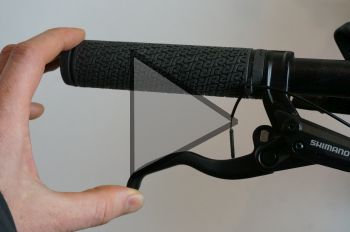Tripwire Ebrake Cutoff

Introduction
Ebrake cutoff levers are an integral part of many ebike systems either to trigger regenerative braking or act as a motor safety shutoff when the rider engages the handbrakes. On conversion bikes this typically requires replacing your entire brake levers with a lower quality 3rd party lever that has an integrated switch, and on systems with hydraulic brakes options are both limited and expensive.
The Tripwire is an ebrake cutoff switch designed for reliable attachment to your existing hydraulic or mechanical brake levers, so that you do not need to replace or modify your entire brake assembly just to have ebrake functionality. Unlike other common approaches using a separate magnet and sensor assemblies which need to be carefully positioned and are prone to misalignment over time, the Tripwire's sensor mechanisms is completely self contained allowing for a simpler and more reliable installation.
Watch the following video for a full introduction and explanation of the two models and how they work.
Features
 The tripwire operates through a small cable secured to the moving part of your lever arm. A sensor located about 8 inches downstream is secured to your brake cable housing or hydraulic hose, and when the brake arm is engaged this cable gets pulled and closes a switch in the snsor to let either your Cycle Analyst or Motor Controller know that the brakes are pressed. There is no need to bleed your lines on hydraulic systems or feed a new brake cable with mechanical brakes, your physical braking system stays exactly the same.
The tripwire operates through a small cable secured to the moving part of your lever arm. A sensor located about 8 inches downstream is secured to your brake cable housing or hydraulic hose, and when the brake arm is engaged this cable gets pulled and closes a switch in the snsor to let either your Cycle Analyst or Motor Controller know that the brakes are pressed. There is no need to bleed your lines on hydraulic systems or feed a new brake cable with mechanical brakes, your physical braking system stays exactly the same.
- Runs of Just 2 Wires, No Need for 5V Power
- Normally Open (N.O.) switch
- Works with your Existing Mechanical or Hydraulic Brakes
- Adjustable Trip Point Position
- Rugged and Watertight Construction
- Results in Tight and Clean Installation
- Stackable Male/Female Connectors for Daisy Chaining Dual Levers, Signaling Brake Lights, or Gearsensor Cutoff
Models
There are two versions of the Tripwire mechanism available depending on the mechanical construction of your brake lever. The first is a 'pull' type of switch which actuates when the cable is pulled from the sensor. This model is used on most mechanical brake levers and certain hydraulic levers where the pivot position is such that squeezing the brakes will pull on the cable attached to the lever.

The 2nd option is a push style of tripwire which actuates when the sensor cable is pushed rather than pulled. This version is required on most hydraulic brake levers where the pivot point is located at the high spot on the lever such that there is no sideways pull when the lever is pressed. In the push style Tripwire, the sense cable is routed into the handlebar before wrapping around to the brake housing. For each of the Pull and Push style brake levers, we have them stocked both in a long (120cm) cable length option for direct connection to a motor controller, and a short (40cm) cable length of attaching to a Cycle Analyst.
Connector Options
In addition to the push and pull mechanism, there are also several options for connector style available for plug and play compatibility with various popular ebike setups. In the past, we used to offer models with a 3-pin HiGo plug for direct compatibility with many bafang BBS and similar systems, as well as a 2-pin HiGo option that was plug and play with Sonders ebikes. We now stock only 4 models: Push or Pull w/ Long or Short cables terminated with a 4-pin JST connector that mates with our controllers and V3 Cycle Analyst.
Installation
The first step in installing the Tripwire is to secure the sense cable to your brake lever, which can be done either with the self tapping screw (preferred) or with small cable ties.
1: Locate a position on your lever where there is a least 5-6mm of travel when the brakes are engaged.
2a: Use the supplied #50 drill to make a small hole in the bottom of the lever at this location, and use the supplied 2-56 self tapping screw going through the cable eyelet
2b: Alternately, use the included cable ties is a criss-cross 'X' pattern through the eyelet to fix the cable to the arm.
3: Position sensor on the brake housing and hold it in place with two cable ties at moderate tightness levels,
4: Connect the ebrake switch to your Cycle Analyst or Motor Controller, and observe where in the travel the switch closes as you press the brakes, and then make sure that the switch releases completely when you let go of the brakes. If the switch does not release then slide the sensor up the cable housing to be closer to the brakes, while if the lever needs to be pressed too far before the switch kicks in then slide the sensor further away.
5: Once the ideal position has been found, then pull the cable ties tight on the sensor body do that it is secured in position. You can always tweak this position later to adjust the engage and release points. In most systems, you will want the tripwire switch to trigger just before the mechincal brake pads start to engage, allowing you to do regenerative braking without the mechanical pads rubbing.
The inventor Tim O'Brien has done an excellent set of video tutorials on installing and tweaking both the Push and Pull type of TripWire sensors:
Availability
The Tripwire is manufactured 100% in the USA under partnership with one of our customers Tim O'Brien who developed this concept for his own ebike conversions. It is available individually from our online store site, as an ebrake option with our conversion kit bundles.


 Canadian
Canadian
 Grin Tech Online Store
Grin Tech Online Store